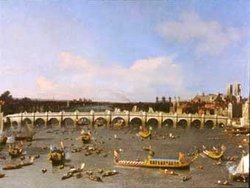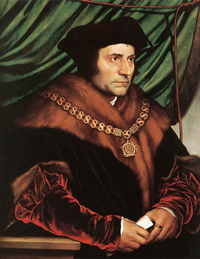Lord Mayor of London
|
|
Michael_Berry_Savory_Lord_Mayor_of_London_Corp_of_London.jpg
The Right Honourable The Lord Mayor of London is the Mayor of the City of London and head of the Corporation of London. The Lord Mayor of London is to be distinguished from the Mayor of London; the former is an officer only of the City of London, while the Mayor of London governs a much larger area known as Greater London. Within the City of London, the Lord Mayor has precedence over other individuals and has various special powers, rights and privileges.
The Lord Mayor is elected each year at the end of September or the beginning of October, and takes office in November. On the day after taking office, the Lord Mayor's Show is held; the Lord Mayor, preceded by a procession, travels to the City of Westminster to swear allegiance to the Sovereign in the presence of the judges of the High Court. The Lord Mayor's role is primarily ceremonial, rather than political, although he does promote London's business credentials abroad.
| Contents |
Titles and honours
Of the 66 Cities in the United Kingdom, the City of London is among the 30 that have Lord Mayors (or, in Scotland, Lord Provosts). The Lord Mayor is entitled to the style The Right Honourable; the same privilege extends only to the Lord Mayors of Bristol, York, Cardiff and Belfast, and to the Lord Provosts of Edinburgh and Glasgow. The style, however, is used when referring to the office as opposed to the holder thereof; thus, "The Rt Hon. The Lord Mayor of London" would be correct, while "The Rt Hon. John Smith" would be incorrect. The latter style applies only to Privy Counsellors.
A woman who holds the office is also known as a Lord Mayor. A male Lord Mayor's wife is known as a Lady Mayoress; no equivalent privilege exists for female Lord Mayor's husband. In speech, a Lord Mayor is referred to as "My Lord Mayor," and a Lady Mayoress as "My Lady Mayoress."
It was once customary for Lord Mayors to be created knights upon taking office and baronets upon retirement. The custom was applied inconsistently from the sixteenth until the nineteenth centuries; creations became more regular from 1889 onwards. From 1964 onwards, the regular creation of hereditary dignities such as baronetcies ceased, but Lord Mayors continued to be granted knighthoods (usually of the rank of Knight Grand Cross of the Order of the British Empire) until 1993. Since 1993, Lord Mayors have not received any automatic honours upon appointment; instead, they have been created Knights Bachelor upon retirement. Furthermore, when foreign heads of state visit the United Kingdom, they sometimes confer honours on the Lord Mayor. For example, in 2001, David Howard was created a Grand Cordon, First Class, of the Order of Independence of Jordan following the state visit of King Abdullah II.
History
The office was instituted in 1189; the first holder of the office was Henry Fitz-Ailwyn. The mayor of the City of London has been elected by the City, rather than appointed by the Sovereign, since a Royal Charter providing for the same was issued by John in 1215. The title "Lord Mayor" came to be used after 1354, when it was granted to Thomas Legge (then serving his second of two terms) by King Edward III. Lord Mayors are elected for one-year terms; by custom, they do not serve more than once.
Almost 700 individuals have served as Lord Mayor of London. Dame Mary Donaldson was the only woman to serve in the office, having been elected in 1983. Numerous individuals have served multiple terms in office, but only two individuals have served for four terms—Nicholas de Farndone (1308, 1313, 1320 and 1323), Hamo de Chigwell (1319, 1321–1322, 1323–1325 and 1327)—and only two others have served for three terms—John de Pulteney (1330–1331, 1333 and 1336) and Richard Whittington (1397, 1406 and 1419). The last individual to serve multiple terms was Robert Fowler (elected in 1883 and in 1885).
Election
Lord_Mayor_of_London's_coronation_robes.JPG
The Lord Mayor is elected by Common Hall, a body of representatives of the City's Livery Companies. Common Hall is summoned by the sitting Lord Mayor; it meets at Guildhall on Michaelmas Day (29 September) or on the closest weekday. Voting is by show of hands; if, however, any liveryman so demands, balloting is held a fortnight later.
Since 1385, prior service as Sheriff has been mandatory for election to the Lord Mayoralty. Two Sheriffs are selected annually by Common Hall, which meets on Midsummer's Day for the purpose. By an ordinance of 1435, the Lord Mayor must be chosen from amongst the Aldermen of the City of London. The people of the city's 25 wards selects one alderman, who holds office for life or until resignation. It is, however, customary for each alderman to submit himself for re-election at least once in six years. An individual elected Lord Mayor need not relinquish membership of the Court of Aldermen.
The Lord Mayor is then sworn in in November, on the day before the Lord Mayor's Show (see below). The ceremony is known as the "Silent Ceremony" because, aside from a short declaration by the incoming Lord Mayor, no speeches are made. At Guildhall, the outgoing Lord Mayor transfers the mayoral insignia—the Seal, the Purse, the Sword and the Mace—to the incoming Lord Mayor.
Lord Mayor's Show
See main article on the Lord Mayor's Show
On the day after being sworn in, the Lord Mayor participates in a procession from the City of London to the Royal Courts of Justice in the City of Westminster, where the Lord Mayor swears his allegiance to the Crown. This procession is known as the "Lord Mayor's Show" and is one of the longest established and best known annual events in London. The Lord Mayor travels in a State Coach that was built in 1757 at a cost of £1,065.0s.3d. (over £120,000 in modern terms). In its modern form is a fairly light hearted combination of traditional British pageantry and elements of carnival. Since 1959 it has been held on the second Saturday in November. Participants include the "Great Twelve" Livery Companies, bands and members of the military. In the evening, a fireworks display is held.
Role
The Lord Mayor is a member of the City of London's governing body, the Corporation of London (incorporated as The Mayor and Commonality and Citizens of the City of London). The Corporation comprises the Court of Aldermen and the Court of Common Council; the former includes only the Aldermen, while the latter includes both Aldermen and Common Councilmen. The Lord Mayor is a member of and presides over both bodies.
The role of the Lord Mayor is primarily ceremonial, rather than political. He hosts visiting foreign dignitaries; furthermore, he conducts several foreign visits of his own in order to promote the British financial sector. Normally, the Lord Mayor visits European nations assuming the Presidency of the European Union.
Banquets hosted by the Lord Mayor often serve as opportunities for senior Government figures to make major speeches. At the Lord Mayor's Banquet (held on the same day as the Lord Mayor's Show), the Prime Minister delivers the keynote address. At the Banker's Dinner in June, the Chancellor of the Exchequer delivers a speech known as the Mansion House Speech, which takes its name from the Lord Mayor's residence. At the Easter Banquet, which is also hosted at Mansion House, a speech is delivered by the Secretary of State for Foreign and Commonwealth Affairs.
The Lord Mayor performs numerous other functions. He serves as the Chief Magistrate of the City of London, Admiral of the Port of London, Chancellor of City University, President of City of London Reserve Forces and Cadets Association, and Trustee of St Paul's Cathedral. The Lord Mayor is also the head of the Commission of Lieutenancy, which represents the Sovereign in the City of London (other counties usually have Lord Lieutenants, as opposed to Commissions), and annually attends the Treloar Trust (named after Sir William Treloar, Lord Mayor in 1906), in Hampshire.
Rights and privileges
The residence of the Lord Mayor is known as Mansion House. The creation of the residence was considered after the Great Fire of London (1666), but construction did not commence until 1739. It was first occupied by a Lord Mayor in 1752, when Sir Crispin Gascoigne took up his residence in it.
It is sometimes asserted that the Lord Mayor may exclude the Sovereign from the City of London. The legend is based on the misinterpretation of the ceremony observed each time the Sovereign enters the City. At Temple Bar the Lord Mayor presents the City's pearl-encrusted Sword of State to the Sovereign as a symbol of the of the latter's overlordship. The Sovereign does not, as is often purported, wait for the Lord Mayor's permission to enter the City.
The importance of the office is reflected by the composition of the Accession Council, a body which proclaims the accession of new Sovereigns. The Council includes the Lord Mayor and Aldermen of London, as well as the Lords Spiritual, Lords Temporal and Privy Counsellors. At the coronation banquet which followed, the Lord Mayor of London had the right to assist the royal butler. The same privilege is held by the Lord Mayor of Oxford; the Lord Mayor of Winchester may assist the royal cook. Such privileges have not been exercised since 1821, when the last coronation banquet (commemorating the coronation of George IV) was held.
The Lord Mayor of London is entitled to wear the Collar of SS, a chain of 28 golden emblems, each in the shape of the letter S (the reason for which is unclear). It is believed that the Collar now used by the Lord Mayor once belonged to Sir Thomas More, and was seized from him upon his execution in 1535. The only other civic officers who may wear Collars of SS are the Lord Chief Justice of England and Wales, the Kings and Heralds of Arms, and Serjeants-at-Arms.
See also
- City status in the United Kingdom
- List of Lord Mayors of London
- Lord Mayor of Dublin
- Mayor of London
- Mayors in the United Kingdom
References
- Corporation of London. (2004). Home Page (http://www.cityoflondon.gov.uk/Corporation)
- Jenkins, S. (2004). "Royal Coronations and Oxford Mayors." (http://www.headington.org.uk/oxon/mayors/government/coronation.htm)
- "London (England)." (1911). Encyclopædia Britannica, 11th ed. London: Cambridge University Press.
- "Lord Mayor's Show." (2002). (http://www.welcometolondon.com/Articles/LordmayorshowOct2001.htm)
- "The Lord Mayor's Show Saturday 13th November 2004." (2004). (http://www.lordmayorsshow.org/)
- "Temple Bar." (1911). Encyclopædia Britannica, 11th ed. London: Cambridge University Press.de:Lord Mayor of London


